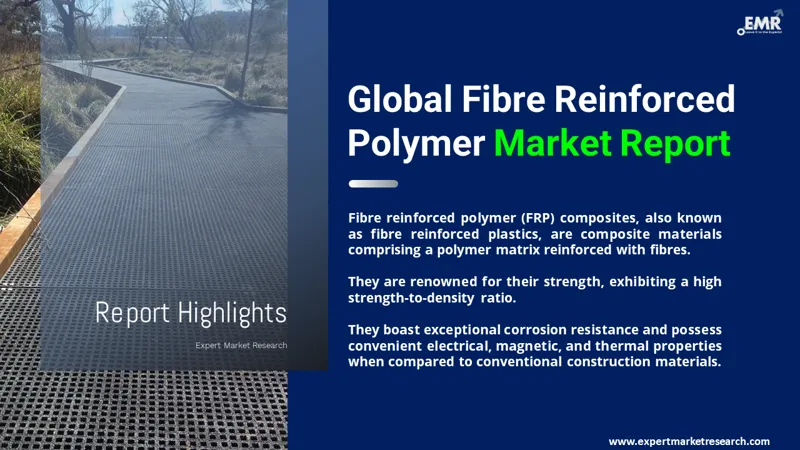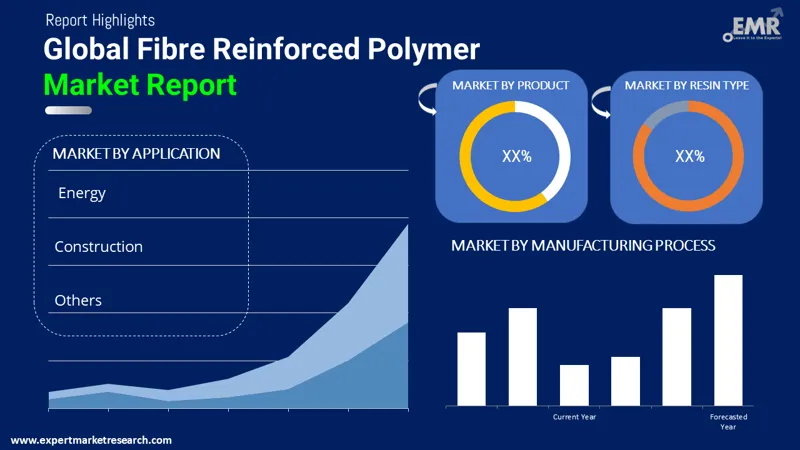
Consumer Insights
Uncover trends and behaviors shaping consumer choices today
Procurement Insights
Optimize your sourcing strategy with key market data
Industry Stats
Stay ahead with the latest trends and market analysis.
The global fibre reinforced polymer (FRP) market was valued at USD 120.55 Billion in 2025 and is expected to grow at a CAGR of 6.90% over the forecast period of 2026-2035 to reach a value of USD 234.93 Billion by 2035. The market is driven by increasing infrastructure rehabilitation projects demanding lightweight, corrosion-resistant materials to enhance structural strength.
Base Year
Historical Period
Forecast Period
Compound Annual Growth Rate
6.9%
Value in USD Billion
2026-2035
*this image is indicative*
| Global Fibre Reinforced Polymer Market Report Summary | Description | Value |
| Base Year | USD Billion | 2025 |
| Historical Period | USD Billion | 2019-2025 |
| Forecast Period | USD Billion | 2026-2035 |
| Market Size 2025 | USD Billion | 120.55 |
| Market Size 2035 | USD Billion | 234.93 |
| CAGR 2019-2025 | Percentage | XX% |
| CAGR 2026-2035 | Percentage | 6.90% |
| CAGR 2026-2035- Market by Region | Asia Pacific | 7.7% |
| CAGR 2026-2035 - Market by Country | India | 8.3% |
| CAGR 2026-2035 - Market by Country | China | 7.7% |
| CAGR 2026-2035 - Market by Application | Energy | 8.1% |
| CAGR 2026-2035 - Market by Product | Carbon | 7.9% |
| Market Share by Country 2025 | Japan | 4.7% |
Based on product, glass fibre reinforced polymers (GFRP) lead the fibre reinforced polymer industry. This can be attributed to the high flexibility and strength of glass fibre reinforced polymers, however, they lack rigidity that is necessary for certain applications. Further, it has better resistance to chemical corrosion, which proves to be very useful in a variety of corrosive environments. Moreover, different composite-manufacturing techniques can be employed to produce GFRP at an economical rate. These factors are aiding the growth of the segment, which, in turn, is further contributing to the growth of the overall market.

Read more about this report - REQUEST FREE SAMPLE COPY IN PDF
Europe and North America account for a significant share in the industry. Within Europe, glass fibre reinforced systems (GRP) remained the dominant material in terms of quantity and accounted for more than 90% of reinforced plastics/composites production in the region. The major application sectors of glass fibre reinforced systems (GRP) are the construction and automotive sectors in Europe. Meanwhile, the Asia Pacific is expected to witness a healthy growth in the forecast period owing to the rapid industrialisation and urbanisation in the region and the increasing use of fibre reinforced polymers in engineering applications.

Read more about this report - REQUEST FREE SAMPLE COPY IN PDF
Fibre reinforced polymer (FRP) composite, also known as fibre reinforced plastic, is a polymer reinforced with fibre. It belongs to a class of materials that is referred to as composite materials. FRP composites are known for their strength as they have a high ratio of strength to density. They also possess exceptional corrosion resistance and convenient electrical, magnetic, and thermal properties as compared to traditional construction materials.
By product, the market is divided into:
Based on resin type, the industry can be segmented into:
On the basis of manufacturing process, the industry can be categorised into:
By application, the industry can be divided into:
Market breakup by region:
| CAGR 2026-2035- Market by | Region |
| Asia Pacific | 7.7% |
| North America | 7.5% |
| Europe | 7.2% |
| Latin America | 6.6% |
| Middle East and Africa | 6.3% |
The global fibre reinforced polymer industry is being driven by the increasing demand from major application sectors, particularly automotive and construction. The increasing demand can be attributed to the favourable properties of the product, particularly its exceptional corrosion resistance property, due to which it is becoming a popular alternative to various ferrous and nonferrous metals. Thus, the growing automotive industry and increasing infrastructure spending in emerging nations are significantly contributing to the market growth. Further, the increasing utilisation of fibre reinforced polymer in engineering applications because of its mechanical properties to obtain significant achievements in the functionality, safety, and economy of construction is also propelling the market growth.
The leading players are continuously working on a wide range of innovative products and product enhancements, such as the development of high-performance (carbon fibre reinforced) sheet moulding compound (SMC) and others, which is expected to significantly contribute to the industry growth in the forecast period.
The report gives a detailed analysis of the following key players in the global fibre reinforced polymer market, covering their competitive landscape, capacity, and latest developments like mergers, acquisitions, and investments, expansions of capacity, and plant turnarounds:
The comprehensive EMR report provides an in-depth assessment of the market based on the Porter's five forces model along with giving a SWOT analysis.
United States Glass Fibre Reinforced Concrete (GFRC) Market
Glass Fibre Reinforced Concrete (GFRC) Market
Carbon Fibre Reinforced Thermoplastic (CFRTP) Composites Market




*While we strive to always give you current and accurate information, the numbers depicted on the website are indicative and may differ from the actual numbers in the main report. At Expert Market Research, we aim to bring you the latest insights and trends in the market. Using our analyses and forecasts, stakeholders can understand the market dynamics, navigate challenges, and capitalize on opportunities to make data-driven strategic decisions.*
Get in touch with us for a customized solution tailored to your unique requirements and save upto 35%!
The market is projected to grow at a CAGR of 6.90% between 2026 and 2035.
The major drivers of the industry include the growing popularity of the glass fibre reinforced polymers (GFRP), favourable properties of the product like corrosion resistance property, rapid industrialisation and urbanisation, and various technological advancements.
The increasing demand from the major application sectors such as automotive and construction and the increasing utilisation in engineering applications are the key trends propelling the market growth.
The major regions in the industry are North America, Latin America, Europe, Middle East and Africa, and Asia Pacific with Europe and North America accounting for the largest share in the market.
Glass fibre reinforced polymers (GFRP)is the dominant product in the industry.
Based on resin type, the industry can be segmented into polyester, vinyl ester, and epoxy, among others.
On the basis of the manufacturing process, the industry can be categorised into pultrusion, vacuum infusion, bladder moulding, compression moulding, thermoplastic extrusion, and filament winding, among others.
The major applications include automotive, electronic, defence, energy, and construction, among others.
The major players in the industry are Mitsubishi Chemical Corporation, BASF SE, Aegion Corporation, Toray Industries, Inc., Celanese Corporation, Advanced Composites Inc., and SGL Carbon SE, among others.
Explore our key highlights of the report and gain a concise overview of key findings, trends, and actionable insights that will empower your strategic decisions.
| REPORT FEATURES | DETAILS |
| Base Year | 2025 |
| Historical Period | 2019-2025 |
| Forecast Period | 2026-2035 |
| Scope of the Report |
Historical and Forecast Trends, Industry Drivers and Constraints, Historical and Forecast Market Analysis by Segment:
|
| Breakup by Product |
|
| Breakup by Resin Type |
|
| Breakup by Manufacturing Process |
|
| Breakup by Application |
|
| Breakup by Region |
|
| Market Dynamics |
|
| Competitive Landscape |
|
| Companies Covered |
|
| Report Price and Purchase Option | Explore our purchase options that are best suited to your resources and industry needs. |
| Delivery Format | Delivered as an attached PDF and Excel through email, with an option of receiving an editable PPT, according to the purchase option. |
Datasheet
One User
USD 2,499
USD 2,249
tax inclusive*
Single User License
One User
USD 3,999
USD 3,599
tax inclusive*
Five User License
Five User
USD 4,999
USD 4,249
tax inclusive*
Corporate License
Unlimited Users
USD 5,999
USD 5,099
tax inclusive*
*Please note that the prices mentioned below are starting prices for each bundle type. Kindly contact our team for further details.*
Flash Bundle
Small Business Bundle
Growth Bundle
Enterprise Bundle
*Please note that the prices mentioned below are starting prices for each bundle type. Kindly contact our team for further details.*
Flash Bundle
Number of Reports: 3
20%
tax inclusive*
Small Business Bundle
Number of Reports: 5
25%
tax inclusive*
Growth Bundle
Number of Reports: 8
30%
tax inclusive*
Enterprise Bundle
Number of Reports: 10
35%
tax inclusive*
How To Order

Select License Type
Choose the right license for your needs and access rights.

Click on ‘Buy Now’
Add the report to your cart with one click and proceed to register.

Select Mode of Payment
Choose a payment option for a secure checkout. You will be redirected accordingly.
Gain insights to stay ahead and seize opportunities.

Get insights & trends for a competitive edge.

Track prices with detailed trend reports.

Analyse trade data for supply chain insights.

Leverage cost reports for smart savings

Enhance supply chain with partnerships.

Connect For More Information
Our expert team of analysts will offer full support and resolve any queries regarding the report, before and after the purchase.
Our expert team of analysts will offer full support and resolve any queries regarding the report, before and after the purchase.
We employ meticulous research methods, blending advanced analytics and expert insights to deliver accurate, actionable industry intelligence, staying ahead of competitors.
Our skilled analysts offer unparalleled competitive advantage with detailed insights on current and emerging markets, ensuring your strategic edge.
We offer an in-depth yet simplified presentation of industry insights and analysis to meet your specific requirements effectively.
Share